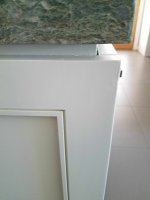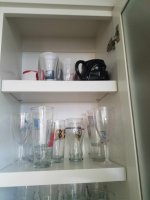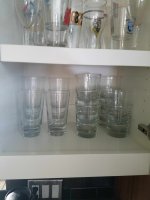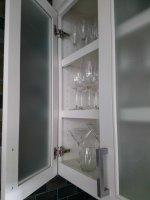insurroundsound
Member
- Joined
- Jul 17, 2008
- Messages
- 45
So, I'm planning out the build-out of my first cabinet [project for wifey and her new day spa]. I'm a hobbyist and tinkerer. Just picked up a DF500 and LR32 kit that I need to break in on this project. I wanna do frameless-style uppers and lowers. For the lowers, I wanna do adjustable legs with a toe kick I'll snap on later.
I'm gonna do 32mm-based cabinets, all heights cut to some multiple of 32mm. Because I never did this before, I have a few questions.
1. I watched erock's youtube videos on use of the LR32 system. Took note of the 768mm tall base cabinet, 110mm toekick. He mentioned in the video that his counter top was not standard. What exactly is "standard"? I heard it was a 1-1/2" countertop. But I took some pics of some cabinets at one of my client's home today and it seems to have a marble countertop + some extra thickness underneath. Is it common to have a base cabinet taller than 36"? I've attached some pics of my client's cabinets.
[attachimg=1]
[attachimg=2]
2. Confusion about how to attach the lowers and uppers to the wall. Plan on putting my cabinets together similar as to in erock's videos. [18mm ply walls; 6mm back wall centered 21mm from rear of cabinet; 18mm rear wall spanners at top and bottom of cabinet, installed flush to back of cabinet] How do you guys hide the screws that are used to attach the cabinet to the wall? I've heard about FastCap covers, but that seems like a lot of work and doubling of labor. I hear d of some putting in an extra 6mm back wall but again, seems like to much effort to cover 4 screws. I took some more pics at my client's house and I could find NO visible screws, but it looked like the spanner board was in the inside of the cabinet and not outside.
[attachimg=3]
[attachimg=4]
[attachimg=5]
[attachimg=6]
Did they install that extra spanner just to cover the mounting screws? I've also heard mention of some sort of cleat system. But how does it actually stay permanently fixed with a cleat system? Wouldn't it be moveable up and down?
Can't wrap my head around these issues. Any suggestions would be appreciated. Thanks!
I'm gonna do 32mm-based cabinets, all heights cut to some multiple of 32mm. Because I never did this before, I have a few questions.
1. I watched erock's youtube videos on use of the LR32 system. Took note of the 768mm tall base cabinet, 110mm toekick. He mentioned in the video that his counter top was not standard. What exactly is "standard"? I heard it was a 1-1/2" countertop. But I took some pics of some cabinets at one of my client's home today and it seems to have a marble countertop + some extra thickness underneath. Is it common to have a base cabinet taller than 36"? I've attached some pics of my client's cabinets.
[attachimg=1]
[attachimg=2]
2. Confusion about how to attach the lowers and uppers to the wall. Plan on putting my cabinets together similar as to in erock's videos. [18mm ply walls; 6mm back wall centered 21mm from rear of cabinet; 18mm rear wall spanners at top and bottom of cabinet, installed flush to back of cabinet] How do you guys hide the screws that are used to attach the cabinet to the wall? I've heard about FastCap covers, but that seems like a lot of work and doubling of labor. I hear d of some putting in an extra 6mm back wall but again, seems like to much effort to cover 4 screws. I took some more pics at my client's house and I could find NO visible screws, but it looked like the spanner board was in the inside of the cabinet and not outside.
[attachimg=3]
[attachimg=4]
[attachimg=5]
[attachimg=6]
Did they install that extra spanner just to cover the mounting screws? I've also heard mention of some sort of cleat system. But how does it actually stay permanently fixed with a cleat system? Wouldn't it be moveable up and down?
Can't wrap my head around these issues. Any suggestions would be appreciated. Thanks!






